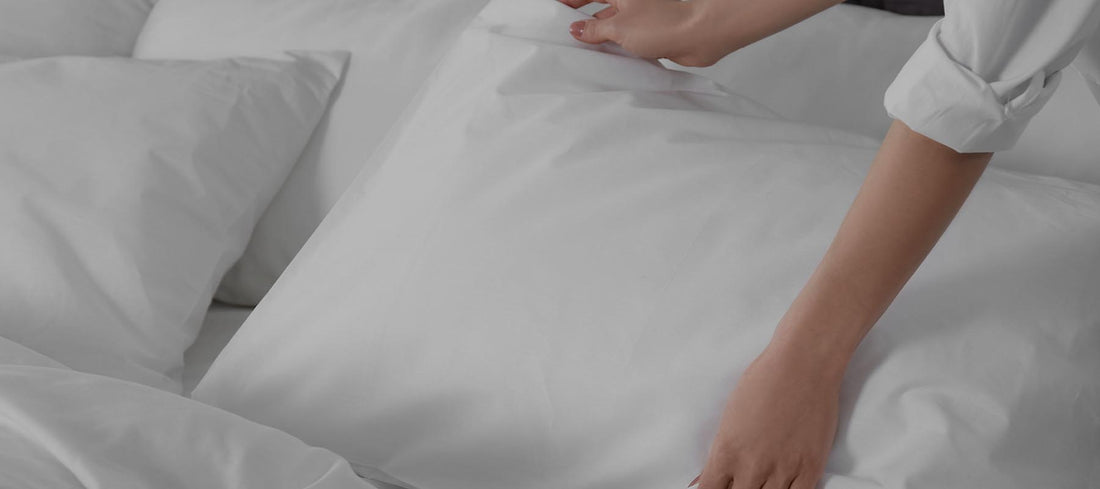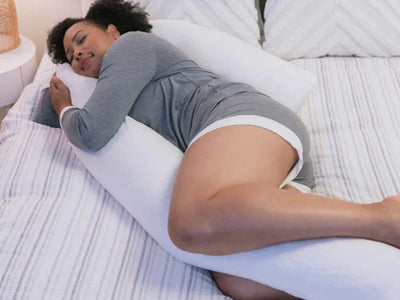
Related Product
How Often Should You Replace Your Pillows?
Share
We all know that a good pillow can impact how well we sleep. But did you know how often you replace your pillows is just as important to your health, hygiene, and sleep quality?
How often you change your pillows depends on a few factors, including what types of pillows you have, how you use them, and what steps you take in caring for them. Read on to learn more about pillow replacement as we discuss how long pillows typically last and how you can extend their lifespan.
Signs Your Pillow Needs Replacement
While it should be pretty apparent when you need to replace your pillows, here are a few common signs it’s time to swap them out.
-
Flat and lumpy - When a quick fluff or spin in the washer and dryer won’t revive a flat, lumpy pillow, it’s time to change it.
Persistent allergens - If you’re suddenly having allergic reactions, like itchy skin and irritated eyes, your pillow might have a buildup of mold, dust mites, and other allergens. - Stains and odors - Even with frequent washing, pillows can develop stains and odor over time. If your pillows start looking discolored and yellow, they’re probably done for.
- Discomfort and neck pain - A saggy, flattened pillow that’s lost shape won’t give you proper support and can leave your neck sore and strained.
The Impact of Pillow Replacement on Sleep Quality
Swapping out your pillows can also impact the quality of your sleep. Here’s why.
- Freshness and hygiene - Even with frequent washing, pillows can develop stains and odor from dirt, sweat, drool, and oil from your face and hair. Over time, this can cause rashes and acne breakouts for sleepers with sensitive skin.
- Allergy management - Dust mites, mold, fungus, and pet dander can all build up on your pillow and cause pillow-related allergies. Replacing your old pillows with new ones that are antimicrobial and breathable can help you find relief.
- Neck and spinal alignment - When a pillow has lost too much loft (its height and thickness), it won’t provide proper head support and neck-to-spine alignment. If you already suffer from shoulder and neck pain, consider replacing your standard pillows with a therapeutic, positional sleep solution instead.
Pillow Types and Their Typical Lifespans
Most pillows generally last one to two years before needing to be replaced. However, the type of pillow you have also determines its typical lifespan.
- Memory foam pillows are made from polyurethane. They change shape under pressure, conforming to your body and supporting the natural curve of your head and neck. These pillows typically last between two to three years.
- Latex pillows offer a similar feel and support as memory foam but are softer to the touch and less firm. Made from rubber tree sap, natural latex is anti-fungal, hypoallergenic, and resistant to mold, mildew, and dust mites. They’re also one of the most durable pillows, lasting around three to four years.
- Down pillows feature the soft undercoating, or inner feathers, of waterfowl. These fluffy pillows offer plush moldability and typically last one to three years. While down pillows are known for their warmth, they also provide more breathability than foam-based pillows.
- Synthetic pillows use polyester fiber or synthetic down to mimic the feel of natural latex or down feathers. These pillows are the most common as they’re affordable. However, they also need to be replaced more often, with a six- to 24-month lifespan.
Factors Affecting Pillow Lifespan
How you use your pillows and how well you care for them will also affect how long they last. Here are a few factors that impact how often you should change your pillows.
- Usage - Your personal and sleeping habits can determine when to replace your pillows. For example, if you like to eat and drink in bed or fall asleep without washing your face, your pillows are more likely to become stained and worn down.
- Climate and humidity - Sleepers in hot climates are more likely to sweat and stain their pillows. High humidity levels can also lead to mold growth, allergens, and excess moisture, breaking down your bedding over time.
Tips for Maintaining and Extending the Life of Your Pillow
Now that we know what can shorten the lifespan of a pillow, here are some tips on how to extend its use.
- Tip 1: Use a pillow protector. This barrier sits between your pillow and pillowcase, offering extra protection from body oil, dirt, dust mites, spills, stains, sweat, and odor.
- Tip 2: Regularly wash and dry your pillows. Follow the care instructions for pillows and toss them into the wash at least once every six months. For pillows that can’t go in the easy, spot-clean them with a warm water and vinegar mixture.
-
Tip 3: Fluff and rotate your pillows. Fluffing your pillows every morning when you make your bed can help them maintain their shape. Plus, it removes any dust that’s collected overnight. Rotating your pillows on varying nights or weeks can also keep them looking and feeling fresh.
- Tip 4: Store your pillows in a cool, dry place. Additionally, keep the pillows that aren’t on your bed in an area without direct sunlight so they don’t lose their shape, color, or quality.
Conclusion
Getting a good night’s sleep is critical to your overall well-being. One easy way to ensure you’re getting proper sleep is to be mindful of your pillow quality and cleanliness and stay on top of when your pillows need replacing.
If you have a medical condition, injury, or sleep disorder, consider changing your sleep position to help you find relief. A specially designed pillow, like
MedCline’s science-backed pillows can also help you ease into this new position, providing comfort and convenience.
At MedCline, we believe in real sleep solutions for real nighttime pain so you can wake up to your best self.
[featured-product]
Resources
Noyed, Daniel. "Types of Pillows." Sleep Foundation, 22 May 2023. https://www.sleepfoundation.org/best-pillows/types-of-pillows
Shannon, Patricia. “How to Fluff Pillows to Perfection: 5 Easy Methods.” Better Homes & Garden, 27 Jun. 2023. https://www.bhg.com/how-to-fluff-a-pillow-7549807
Sabella, Maria. “22 Ways to Properly Store Your Pillows.” The Spruce, 01 Nov. 2022. https://www.thespruce.com/pillow-storage-ideas-6821927
Breus, Michael. “When Should You Replace Your Pillow?” Sleep Doctor, 13 Dec. 2022. https://sleepdoctor.com/pillow-information/when-should-you-replace-your-pillow/
Fountain, Lauren. “How Often Should You Replace Your Pillows?” Sleep Foundation, 22 May 2023, https://www.sleepfoundation.org/bedding-information/how-often-should-you-replace-your-pillows
Nelson, Angela. “Memory Foam Pillows: What You Need to Know.” Web MD. 15 Nov, 2022,
https://www.webmd.com/sleep-disorders/memory-foam-pillows-what-to-know
Fountain Lauren. “Down vs. Feather Pillows.” Sleep Foundation, 13 Feb. 2023, https://www.sleepfoundation.org/best-pillows/down-vs-feather-pillows



